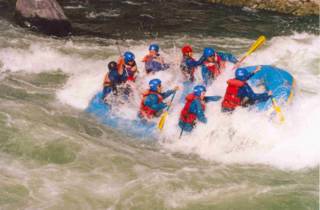
An Andean Condor soars high above the rivers which create the deep canyons of Peru.

From Cusco, the commercially rafted section of the Apurimac is a convenient 3-4hr ride by bus and although the rafting trips take 3-4 days to complete, the length of the run is less than 40km and can be kayaked in two days. Basically the paddling season begins when the rains come to a stop in June (navigable high water), and ends in October (low water). Even if you haven't come to Peru with the main purpose of paddling, upon reaching Cusco, you will be amazed to discover that next to Machu Picchu and the Inca Trial, rafting the Apurimac is the next place of interest among thrill seekers from abroad. Although low safety standards do exist on a river with numerous class IV hazards and rock sieves, you can experience a 3-4 day raft trip down one of the deepest canyons in the world for less than 175.oo Cdn. As a recommendation, stay safe by NOT paddling "Dolore de Muela", a sketchy and long class V that for some reason Peruvians take their guests down until somebody dies!

Another salad tossing about to happen in the Baticueva hole on the Rio Apurimac, Peru.

When Michelle and I drove into Cusco in August 2003 with kayaks on our van, we were quickly confronted by Peruvian raft guides who were very informative and genuinley nice. Before the night was through I had been asked by Willy from Southern Rivers if I would like to safety kayak on his next Apurimac trip. After some negotiation (which included getting Michelle on the raft trip), I agreed and two days later we set out on another great adventure. This ended up being a 2 month job for me and by the end Michelle had also descended the Apurimac 3 times in raft and once in her kayak.

Willy from Southern Rivers guiding Michelle (red helmet) and the rest of the crew down the Rio Apurimac, Peruvian style!

Before the Apurimac reaches the lowlands of the Amazon basin, it plummets down through the high Vilcabamba plateau and into the Abismo Gorge. The Abismo Gorge section begins directly after the commercial takeout at the town of Curahuasi where a new bridge was installed in the early 90's on the Abancay-Cuzco road. Still considered one of the most intimidating sections of river that one could find in South America, the Abismo gorge's window of opportunity comes in October when the water is at its lowest, yet only days before the start of the heavy rains and Peru's "wet" season. The late Russell Kelly of Ophir Colorado, having no fears solo kayaking inescapable canyons worldwide, ran the Abismo both in 2002 and 2003 with little time to spare before the rapids became unavigable.



